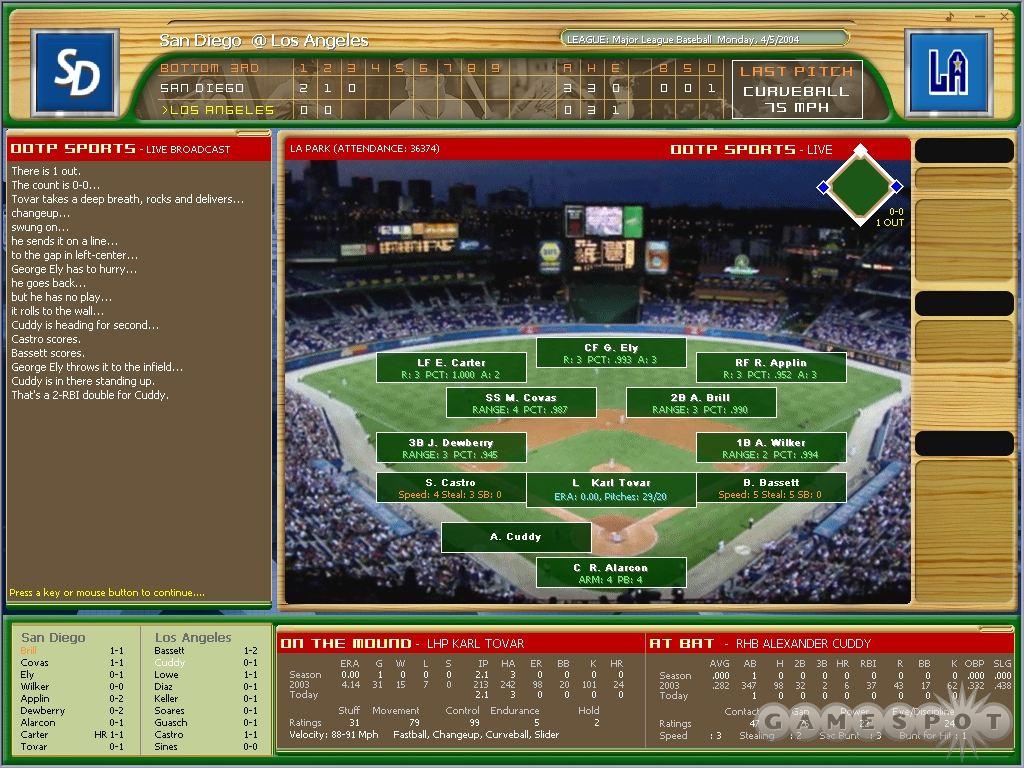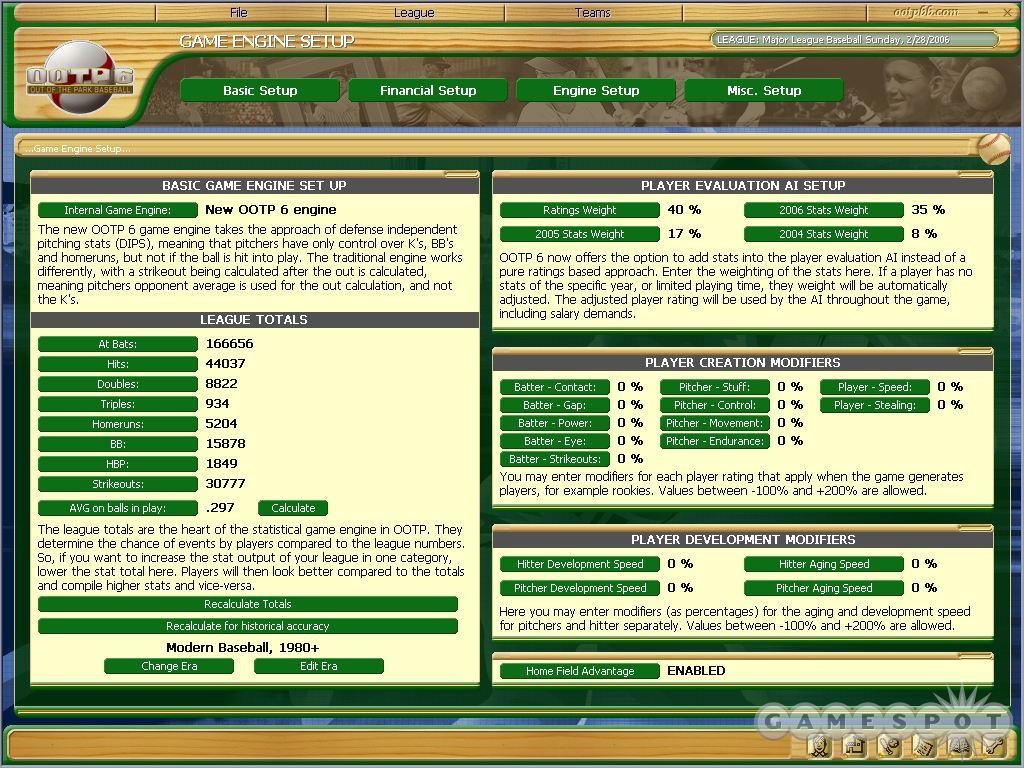"As real as it gets." This is the slogan for Out of the Park Baseball 6. And in this case, it seems like there is truth in advertising. Lead designer Markus Heinsohn has reworked the game engine to provide more realism, more management features, improved artificial intelligence, and an editor that allows you to adjust player rating and performance settings. This text-based baseball management simulation (available only online via the official Web site) may look a lot like its predecessors, but all of these new features give the game an unmatched feeling of authenticity.

There is more under the hood in just about every area of the new game. While the game design, of course, still focuses on running a big-league baseball franchise from the minors to the majors--and in solo leagues or against online human opposition--the new game adds a great deal of depth. This is particularly true in regard to the player rating system. All of the old categories have been tossed in favor of replacements that leave less to the imagination. As a result, the system of evaluating players is tighter. You get the sense that you're rating the real abilities of real people now, not just matching the ratings with the statistics.
Pitchers, for instance, are now rated on actual skills, like stuff, control, and movement, instead of the vaguer categories used previously, like avoiding runs and avoiding home runs. Their pitch speeds are clocked as well, so you can easily tell fireballers from breaking-ball specialists. Batters have also been fine-tuned, with rating categories such as contact, eye/patience, gap power, and running instincts. Talent is now given a score in each skill rating, so you can see if a player is living up to expectations or not.
This new system makes it easier to evaluate players, yet it also adds more guesswork, because you're now dealing strictly with player capabilities and not how a player should respond in a given situation. So that hotshot young starting pitcher may have fantastic stuff, but you have to keep an eye on how he's performing in games to see whether or not he can keep runs off the scoreboard. You now have to mix rating scores with box scores to determine a player's real worth, upping the game's realism (and its difficulty) and also making you feel a lot more like the general manager of a real ballclub.
These ratings, along with the star system that rates a player's entire package of abilities, also seem more credible than they were last year. OOTP 5 had some problems with the abilities of top young prospects and star older players. A prospect might celebrate his 25th birthday and immediately go from a 4.5-star prospect with great numbers in all rating categories to a 1.5-star bum. A 37-year-old veteran with four stars in October might have only one star by the following season's spring training. Scores now are more fluid, and the sudden drop-offs are no longer an issue. Stars and ratings fluctuate a fair bit during each season, so you'll have to keep an eye on both these numbers and the stat categories.

Best of all, players can now come back from star and rating declines. Before, when a prospect tanked or a veteran suddenly got old, that was pretty much it. That's no longer the case. For example, we traded for the top prospect in the league during one season only to see him immediately plummet from five stars to one star. As a result, he became a long shot to make it in the majors. However, we stuck with him, and he responded with a fantastic year that saw all his numbers and his star rating gradually rise. By September, he had regained budding superstar quality.
If you don't like the ratings generated by OOTP 6's default settings, you can alter them in the game engine setup screen. For the first time in the history of the series, you can tweak the ratings system and modify how players are evaluated by adjusting the base weighted percentages by up to 200 percent of the default values. You can even use this feature to take stats into account when determining ratings so that performance on the field directly translates into evaluations by the artificial intelligence. Unfortunately, the game download file comes without any advice on how to use the engine setup options (and it doesn't even include a manual), so a lot of trial and error is required to make changes to your league. Thankfully, there is a thriving user forum at the official Web site.
More realism has also been added to league organization. Although you can still start with the basic 25-man major league roster used in past years, OOTP 6 supports the extended 40-man roster and the Rule 5 draft, which exposes unprotected players. Arbitration and free agency have also been beefed up, largely by tracking player rights to these things by days of major league service. This way, you can now make late-season call-ups for a month or so without sacrificing a full year of the player's contract status. Putting a player on waivers has also been introduced, so you can't freely move players from the big club to the minor leagues without the risk of another team claiming them.

Amateur drafting is much more complex as well. Players now come out of high school or college, and their schools are identified. This means that you have to look at what their level of competition was and take this into account when reviewing their ratings and statistics. You also have to fork over a signing bonus to each pick. The draft screen has been nicely remodeled as well. Simply clicking on a player brings up a full scouting report that lists past statistics, ratings, alma mater, a brief summation of the player's skills, and a prospect rating that shows the likelihood of that player making the show. As with many other features in OOTP 6, the new draft adds a great deal of depth to the game.
Topping off all of this is enhanced computer logic. The opposition is now smarter across the board, particularly during manually managed games, where decisions that regard pitching moves seem a lot more astute than before. Trading proposals make more sense, too. We were approached with a lot of smart deals, including some packages that involved up to four players. Computer general managers seemed aware of our team's weaknesses as well. We went into one year with a hole at shortstop, and nearly every rival in the league tried to unload their excess utility infielders on us.
And it takes a lot to get a lot. Going after top prospects requires serious talent in return. Rivals hold out for what they want and typically provide a short list of your best players as acceptable trade bait if you're looking to deal for a top prospect or an established star. Veterans are still more highly valued than prospects, although it's hard to complain about this, since that's how things work in the real major leagues as well. And speaking of the real world, cash is now a factor in deals. You can throw money into any trade to sweeten the pot, although the impact of doing so seems negligible unless your check includes many, many zeroes. We were unsuccessful at making money-supported trades unless we threw in at least 5 million smackers. Even this didn't do much to change what the computer general manager wanted in terms of players.
As for drawbacks, there are a few. The most noteworthy problem, at least for some, is that the game now takes into account modern baseball thinking, which has turned on-base percentage into the Holy Grail. So computer teams often feature lineups with high OBP-players at the top of the order rather than the traditional light-hitting speedsters. This can be a real hurdle for players who use the historical game options to re-create past baseball seasons.

Game simulation speed is another issue. OOTP 6 is perhaps even a little slower than its predecessor in simming games, and there are still annoying pauses when your season is automatically saved while simming. Adding a way to shut off the autosave feature would be most welcome. Graphics and sound are carried over from last year's edition almost entirely. At least the manual game simulation screen looks better than ever. It also features more statistical information about players in game situations, making your life as a bench-boss much easier. You can even see last year's statistics for pitchers and players coming to bat, which is always handy early in the season.
These criticisms are pretty minor, though. OOTP 6 is an impressive step forward in what has already proven to be a great baseball management series. What's more, it demonstrates that you don't need a lot of cosmetic changes to make solid improvements to a sequel. This might not quite be "as real as it gets," but this franchise gets closer to that goal each and every year.